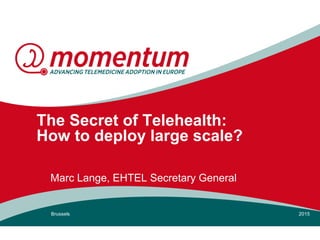The Secret of scaling-up innovation in healthcare - The Momentum Blueprint
- 1. The Secret of Telehealth: How to deploy large scale? Marc Lange, EHTEL Secretary General Brussels 2015
- 2. Momentum: the Project A CIP ICT-PSP thematic network Running from February 2012 until December 2014 The consortium: 20 organisations Telemedicine associations and competence centres from Denmark, United Kingdom, Estonia, Norway, Spain, France, Sweden, Germany, Greece, Netherlands, Poland, Switzerland European stakeholder associations representing Health professionals and health care organisations, health insurers, technology vendors 2015Brussels
- 3. Brussels 2015 Scaling-up? From pilot to routine care ˇ
- 4. Tools and methods are needed to deploy telehealth Impact assessment framework The results and lessons learned from Renewing Health The deployment study of United4Health Business Model Canvas Cost and benefit analysis toolkit Guidelines/Gap Analysis for large-scale deployment 2015 Brussels
- 5. The challenge: NT+OS=NOS New Technology + Old System = New Old System Brussels 2015
- 6. 2015 A European Telemedicine Deployment Blueprint Brussels By Doers, for Doers
- 7. Strategy & Management Legal,, Regulatory & Security Organisation Implementation & Change Management Technical & Market relations Four domains for deployment guidelines 2015Brussels
- 8. Telemedicine service Run Plan People Context IT & eHealth infrastructure 16 Legal & sec. guidelines 13 Legal & sec. conditions 11 Legal & sec. experts 14 Market procurement 18 Service monitoring 17 Change management 10 Cultural readiness 1 Leadership 3 Compelling need 2 User friendliness 6 Potential to scale-up 12 Primary client 8 Business plan 9 Privacy awareness 15 Patient centeredness 5 Stakeholder involvement 4 Resource aggregation 7 Strategy and management Organisation and management Legal and security Technology and market Enabling service deployment: 18 Critical success factors 2015Brussels
- 9. Brussels 2015 With TREAT (Telemedicine REadiness Assessment Tool) A Doer working on a deployment plan for a particular telehealth service Will use these 18 Critical Success Factors to assess his plan ¨C collectively ¨C against a set of indicators CSF 1. Assure that there is cultural readiness for the telemedicine service In my organisation/region, ? doctors and other healthcare professionals are ready to share clinical information with each other and with the patient ? financial and other incentives are aligned with the service to be deployed ? an underpinning culture embraces technology ? an underpinning culture welcomes and even promotes change
- 10. MOMENTUM ¨C TREAT workshop Brussels 2015 Based on the results from the online tool Key players in the telemedicine project are brought together to examine their local strategy and their execution targets Expected outcome: A common understanding between stakeholders on the challenges that they are facing Input for issues that need to be changed or adapted in existing strategies A first draft of an action plan for the large-scale implementation of telemedicine
- 11. Scaling-up? From pilot to routine care Brussels 2015
- 12. Testimonials (to date) Brussels 2015 October 2014 April 2015
- 13. Any questions? More at www.telemedicine-momentum.eu Brussels 2015 Marc Lange Secretary general EHTEL Association 49/51, rue de Tr¨¨ves B-1040 Brussels Belgium Tel: +32 (0)2 230 15 34 Fax: +32 (0)2 230 84 40 Mobile: +32 (0)475 27 71 45 Marc.Lange@ehtel.eu www.ehtel.eu
- 15. Critical Success Factors for Deployment Strategy Brussels 2015 1. Ensure that there is cultural readiness for telemedicine services. 2. Ensure leadership through a champion. 3. Come to a consensus on the advantage of telemedicine in meeting compelling need(s) 4. Put together the resources needed for deployment. Strategy & Management Legal, Regulatory & Security Organisation & Change Mgmt. Technical & Market relations
- 16. Critical Success Factors for Organisational Change Brussels 2015 5. Address the needs of the primary client(s). 6. Involve health care professionals and decision- makers. 7. Prepare and implement a business plan. 8. Prepare and implement a change management plan. 9. Put the patient at the centre of the service. Strategy & Management Legal, Regulatory & Security Organisation & Change Mgmt. Technical & Market relations
- 17. Strategy & Management Legal, Regulatory & Security Organisation & Change Mgmt. Technical & Market relations Critical Success Factors for Legal, Regulatory and Security Compliance Brussels 2015 10. Assess the conditions under which the service is legal. 11. Identify and apply relevant legal and security guidelines. 12. Involve legal and security experts. 13.Ensure that telemedicine doers and users are ˇ°privacy awareˇ±.
- 18. Strategy & Management Legal, Regulatory & Security Organisation & Change Mgmt. Technical & Market relations Critical Success Factors for Technology Decisions and Procurement 2015 14. Ensure that the IT and eHealth infrastructures needed are available. 15. Ensure that the technology is user-friendly. 16. Put in place the technology and processes required to monitor the service. 17. Maintain good procurement processes. 18. Guarantee that the technology has the potential for scale-up (i.e., ˇ°think bigˇ±). Brussels


















